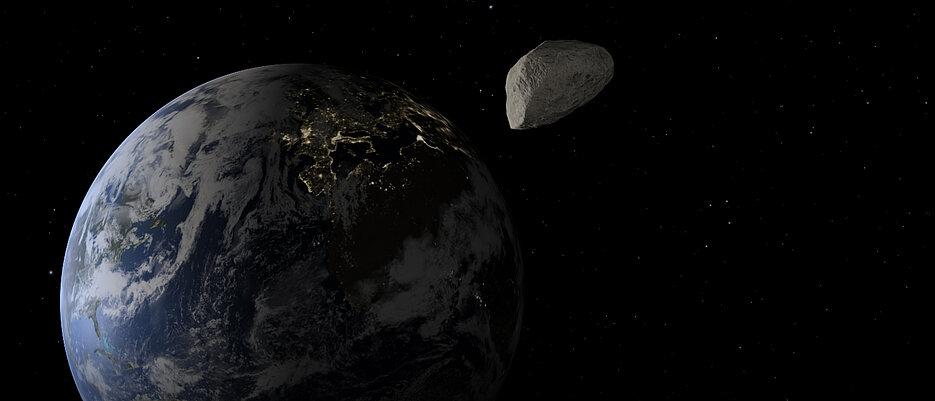In five years' time, a large asteroid will fly very close to Earth - a unique opportunity to study it. Concepts for a national German small satellite mission are being examined at the University of Würzburg.

The author of a disaster novel couldn't have dreamed it up any better: On a Friday, the thirteenth of all days, the potentially dangerous asteroid (99942) Apophis will come extremely close to humanity. On 13 April 2029, there will only be around 30,000 kilometres between the cosmic rock and Earth. It will then be possible to see Apophis with the naked eye as a point of light in the evening sky, even from Würzburg.
What makes the asteroid so dangerous: its average diameter is an impressive 340 metres. If it were to hit the Earth, the destruction caused by an impact on land would be enormous. "The impact crater alone would probably have a diameter of several kilometres, and the force of the impact could devastate an area the size of Central Europe," estimates Jonathan Männel, research associate at the Professorship for Space Technology at Julius-Maximilians-Universität Würzburg (JMU) in Bavaria, Germany.
But don't panic: At least for the next 100 years, Apophis will spare the Earth, as NASA has calculated. Since the asteroid was discovered in 2004 and classified as dangerous, the US and other space organisations have been keeping a close eye on its orbit and now know that it will fly past the Earth.
Apophis Offers a Rare Opportunity for Research
Asteroids are irregularly shaped objects that move in orbits around the sun. To date, around 1.3 million asteroids are known to exist in our solar system, and around 2500 are considered potentially hazardous for the Earth. Potentially Hazardous Asteroids (PHA) are near-Earth asteroids whose orbits are less than 20 lunar distances from the Earth's orbit and whose diameter is of over 140 meters (460 ft). Science does not know very much about asteroids: to date, there have only been around 20 satellite missions that have targeted these celestial bodies.
What is the structure of asteroids? What influences their trajectory? What happens to them when they fly close to other objects and feel their gravitational pull? There are many questions to be answered. Because an asteroid of this size only comes so close to Earth every 1000 years, there is a rare opportunity to study the asteroid with relatively little effort. In doing so, mankind could also gain knowledge that could be used to develop defence measures against dangerous asteroids.
Three Concepts are Scrutinised
What contribution could Germany make to the research into Apophis? A JMU team led by aerospace engineer Professor Hakan Kayal is investigating this question in the NEAlight project.
With around 300,000 euros in funding from the Federal Ministry for Economic Affairs and Climate Action, currently the project leader Jonathan Männel and research assistants Tobias Neumann and Clemens Riegler are investigating three concepts for German small satellite missions. All three are based on the results of the SATEX project from 2023, in which the Würzburg team analysed the potential of small satellites for interplanetary missions.
Concept number one: For a national mission, Kayal's team is building a small satellite that will accompany the asteroid Apophis for two months on its way to its closest point to Earth and stay with it for a few weeks afterwards. During this time, the changes in Apophis will be documented photographically and analysed using various measurements. This strategy poses a number of technical challenges, as the small satellite has to cover a long distance and function largely autonomously.
Concept number two: Germany is participating in the planned European RAMSES mission. This envisages a larger satellite, equipped with small satellites, telescopes and other measuring instruments, which will fly to Apophis and accompany it on its flyby of the Earth over a longer period of time. One of the small satellites could be from Würzburg and study the asteroid in conjunction with the other satellites. For the JMU team, the technical effort involved would be less and the scientific knowledge gained would be greater. Whether the RAMSES mission is ultimately realised also depends on the willingness of the European ESA partners to co-finance the project.
Concept number three: A small satellite built at JMU flies briefly past the asteroid when it is closest to Earth and takes photos. This would demonstrate that such a mission is also possible with inexpensive small satellites. The effort involved would be relatively small, but the observation time would be short and the knowledge gained would probably be rather small. This mission could begin a few days before the arrival of Apophis - with the first two concepts, the satellite would have to be launched a year earlier.
Elaboration of the Scenarios by April 2025
In the NEAlight project, Kayal's team will work out the requirements for these three mission scenarios in detail, define the basic mission architectures and evaluate the realisation options. It will also use the three concepts to consider realisation options for future interplanetary small satellites that fly to the moon or other near-Earth asteroids (NEA), for example.
The project was launched at the beginning of May 2024 and will run for one year. It is being carried out at the Interdisciplinary Research Centre for Extraterrestrial Studies (IFEX) at the JMU Professorship for Space Technology.
The project "Investigation of small satellite mission ideas to Near Earth Astroids (NEA) with a focus on (99942) Apophis" (NEAlight) is funded by the German Aerospace Centre (DLR) with around 306,000 euros from funds of the Federal Ministry of Economics and Climate Action on the basis of a decision of the German Bundestag under the funding code 50OO2413.






